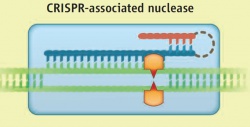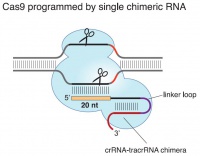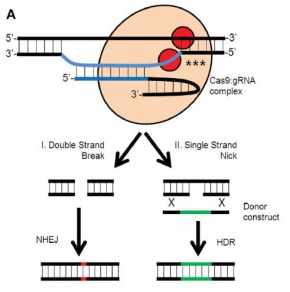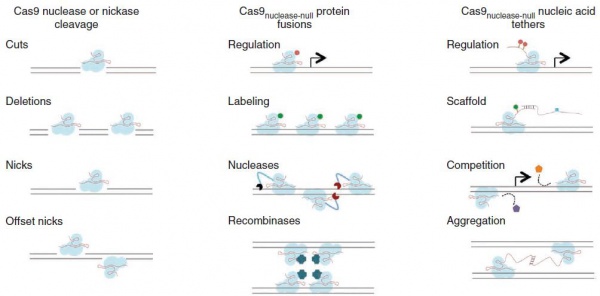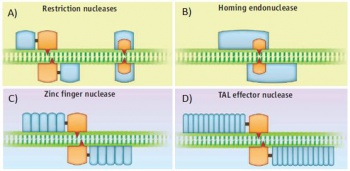CH391L/S14/CRISPR
Contents |
CRISPR/Cas RNA-guided endonucleases
The CRISPR/Cas system is an RNA-guided endonuclease system found naturally in many prokaryotes. By guiding endonucleases, enzymes that cleave within double stranded DNA, with a short 20 nucleotide (nt) RNA sequence, this complex can target and cleave a virus or plasmid at a single genomic region and efficiently prevent an invasion [1] [2]. CRISPR stands for Clustered Regularly Inter-Spaced Palindromic Repeats. This small genomic region (less than 1kb) is a critical part of the bacterial defense system against foreign DNA, mainly because it is known to retain genetic information about previous encounters with phage or plasmid DNA. Cas genes, are CRISPR associated genes that encode for several proteins with roles in the formation of the RNA-guided endonuclease complex [2].
How CRISPR/Cas system works in nature
- Adaptation
Clustered Regularly Inter-Spaced Palindromic Repeats are genomic regions where prokaryotes are known to retain the footprint -sequence fragments- of previous encounters with virus or plasmid DNA. The way it works in nature is that any newly encountered invader that the bacteria survives gets cleaved and fragments from the foreign DNA (called spacers) get incorporated between short repeat sequences in CRISPR regions.
- crRNA Biogenesis
The CRISPR loci are transcribed to produce CRISPR RNA (crRNA), containing diverse repeat-spacer sequences which then are processed to become part single RNA-guided CRISPR/Cas complex - that is, each CRISPR/Cas complex will retain only one spacer. During crRNA biogenesis, trans-activating crRNAs (tracrRNAs) bind to the repeat sequences in the newly transcribed long CRISPR’s transcript, triggering the transcript to be processed (by RNAse III) into the discrete space-repeat Cas bound sequences that make the mature CRISPR/Cas complexes. The spacer that remains in the CRISPR/Cas complex becomes the RNA-guide component ready to detect the complementary sequence in invading DNA by guiding Cas nuclease domains to cleave at the specific target site (called protospacer).
- Invader silencing (gene interference)
Once a CRISPR/Cas system detects the target foreign DNA, it binds, unwinds and cuts at the precise complimentary sequence. It only requires additional presence of a protospacer adjacent motif (PAM) that is encoded at the 3'-end of the spacer (20 nucleotide) sequence. Thus, in nature, the CRISPR/Cas system is essentially an adaptive bacterial defense system against viruses and foreign DNA. A nice CRISPR/Cas video has been posted on Youtube which shows gene interference by this system in action.
CRISPR/Cas gene editing
Not much after its discovery, CRISPR/Cas systems in combination with recombination techniques were successfully used to modify genes and regulate gene expression [3]. Very recently CRISPR/Cas gene editing has been shown to work even in human cells [4] [5]. The unprecedented versatility of the CRISPR/Cas system has empowered scientist with an easily programmable and surgically precise DNA editing tool.
There are three types of CRISPR/Cas systems, but the main difference is that type I and type III systems depend on a large multi-Cas protein complex, while on type II systems only Cas9 is responsible for crRNA-guided silencing. It is for this reason that CRISPR/Cas9 type II systems have been preferentially used for DNA editing applications given that the only thing needed to target a DNA sequence is to modify the guide crRNA. RNA-programmed Cas9 has been the tool of choice with proven versatility for genome engineering in multiple cell types and organisms [3][6][7][8].
Considering that in its natural form any CRISPR/Cas system depends on the incorporation of a trans-activated CRISPR RNA (tracrRNA), an element which can be transcribed elsewhere in genomic or vector DNA, this adds an additional component that needs to be added for the active RNA-guided endonuclease. Nonetheless, an important development was made by Jinek et al.(2012)[7] by creating a crRNA chimera that included tracrRNA, simplifying CRISPR/Cas editing into a single RNA-guided Cas9 (Fig.1). This proves that the system can be simplified by just constructing a chimeric guide RNA.
CRISPR-Cas system genome editing (Fig.2) generally involves three steps: (1) site specific double-stranded DNA break (DSB) (2) activated DNA repair machinery (3) Non-homologous end joining (NHEJ) or homologous recombination (HR). NHEJ results in nucleotide insertions and deletions at the DSB site. Elimination of one of Cas9 nuclease domains allows single strand DNA cleavage to favor NHEJ. This provides the opportunity for the experimenter to add designed oligonucleotides (donor construct) to perform gene editing at the specific cleavage site.
Making RNA-guide sequences
The critical component of the CRISPR/Cas editing system is the RNA-guide sequence to fit the desired need for the target double stranded DNA of choice. You can use the convenient RNA-guide design tools available at ADDGENE, along with a collection of CRISPR/Cas protocols and plasmids designs for various applications. You can also order the sequence to be artificially synthesized from(IDT).
Advantages
- Easy to program targeted gene specific modifications using the CRISPR-Cas9 system, given it merely requires changing the sequence (20bp) of the guide RNA.
- Amenable to high-throughput construction of a library of targeting vectors - multiplexing [6].
- Works on nearly all cell types and organisms [9]
Disadvantages
- Offsite nuclease activity (off-target cleavage): up to 5 mismatches are tolerated between crRNA and target DNA [10]. This problem is being addressed and recently it was demonstrated that shortening the guide RNA increases specificity [11].
- Efficiency: it has been suggested that efficiency may be improved by rational design, directed evolution, or a combination of both [3]
Applications of CRISPR/Cas systems:
Several promising applications have been developed taking advantage of the CRISPR/Cas system, including:
- Removal of a bacterial strain by use of genome targeting [12]).
- Proteins can be targeted to any dsDNA sequence by simply fusing them to Cas9 [3].
- Targeted genome regulation
- RNA-guided genome editing in plants [8]
Among the many exciting possibilities of CRISPR/Cas editing is the demonstration of its use as a multiplex editing tool where several genetic modifications can be achieved at once by designing CRISPR sequences with several spacers [6]. Many other applications in gene regulation and targeted DNA strategies can be designed, as illustrated by the following image:
Different nuclease-mediated genome editing
Decades ago, the discovery of nucleases, enzymes that cut DNA, opened the door to DNA editing. While exonucleases cleave terminal nucleotides of a DNA strand, endonucleases cleave within a DNA strand and these can do so randomly, structure-specific or at precise short DNA sequences. Breakthroughs in our ability to edit genes have come in the form of techniques with better specificity, which means the targeting of a genomic sequence while excluding cleavage at other sites. Zinc finger nucleases (ZFNs), transcription activator-like effector nucleases (TALENs) and homing meganucleases can be programmed to cleave at a specific genomic site, but these can be costly and challenging to make (for comprehensive reviews on nuclease-mediated geneome editing see [13] [14])
iGEM
Many iGEM teams are working on synthetic biology applications with the CRISPR/Cas system due to its modularity and easily programmable DNA targeting. For example, the UBC iGEM team developed a modular way to confer resistance to known phage genomes as a way to vaccinate a host cell. The Stanford iGEM team worked on a system for passing DNA regulatory messages between cells and so far submitted bricked components of two of these novel CRISPR/Cas systems. The USC iGEM team successfully constructed CRISPR/Cas systems to use as a method for plasmid curing. The UCSF iGEM team has worked on CRISPR/Cas systems to target specific strains without disrupting the entire microbiome and the ASU iGEM team has designed and submitted several CRISPR/Cas biobricks targeting gene regulation.
Most notably, considerable work has been done by the Freiburg iGEM team, which developed what they called the uniCas toolkit for gene regulation. Just two examples of their most interesting constructs, a gene activator and a repressor are shown below:
Visit their excellent website to see more and play cool animations illustrating the mechanism of action of these novel synthetic biology tools.
References
Error fetching PMID 23664777:
Error fetching PMID 17379808:
Error fetching PMID 23495939:
Error fetching PMID 23287722:
Error fetching PMID 24362028:
Error fetching PMID 22745249:
Error fetching PMID 23287718:
Error fetching PMID 24253446:
Error fetching PMID 24473129:
Error fetching PMID 24076990:
Error fetching PMID 23956122:
Error fetching PMID 24584096:
Error fetching PMID 24463574:
- Error fetching PMID 17379808:
CRISPR provides acquired resistance against viruses in prokaryotes. - Error fetching PMID 23495939:
CRISPR-Mediated Adaptive Immune Systems in Bacteria and Archaea - Error fetching PMID 24076990:
Cas9 as a versatile tool for engineering biology. - Error fetching PMID 23287722:
RNA-guided human genome engineering via Cas9. - Error fetching PMID 24362028:
A Cut above the Rest: Targeted Genome Editing Technologies in Human Pluripotent Stem Cells. - Error fetching PMID 23287718:
Multiplex Genome Engineering Using CRISPR/Cas Systems - Error fetching PMID 22745249:
Programmable Dual-RNA-guided DNA endonuclease in adaptive bacterial immunity - Error fetching PMID 23956122:
RNA-guided genome editing in plants - Error fetching PMID 24584096:
CRISPR-Cas systems for editing, regulating and targeting genomes - Error fetching PMID 24253446:
Analysis of off-target effects of CRISPR/Cas-derived RNA-guided endonucleases and nickases. - Error fetching PMID 24463574:
Improving CRISPR-Cas nuclease specificity using truncated guide RNAs. - Error fetching PMID 24473129:
Programmable removal of bacterial strains by use of genome-targeting CRISPR-Cas systems. - Error fetching PMID 24387662:
Nuclease-mediated genome editing: At the front-line of functional genomics technology - Error fetching PMID 23664777:
ZFN, TALEN, and CRISPR/Cas-based methods for genome engineering
